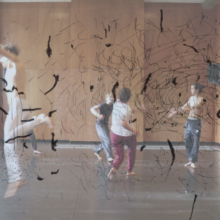Movement
Generating a better understanding of the effect of spatial qualities on the embodied experience in (semi-) public spaces: reconsidering the design process by examining human motion
This research project examines human movement in an architectural context, with the aim to generate new useful insights for architectural design processes. Movement plays a crucial role in the experience of space. It’s only by moving through spaces that we can experience architecture. Therefore movement can be seen as an essential component within the architectural practice. Yet architecture usually results from a static approach.
By focusing on ‘traces’ of body movements and the space taken up in relation to their physical environment, this PhD project examines the significance of body movements in a given space and, by extension, the significance of embodied experience in an architectural context. The research is conducted through designing and evaluating spatial interventions in public spaces, by which it aims to interfere in the design process, to develop innovative design strategies and to assess their impact.
A PhD project by Liselotte Vroman
Supervised by Thierry Lagrange
Co-supervised by Dimitri Vangrunderbeek
Latest
 | 07.07.21 | Public PhD defence of Liselotte Vroman |
 | 04.02.20 | Move to Design, Design to Move |
 | 13.11.17 | Preliminary Experimental Setups |